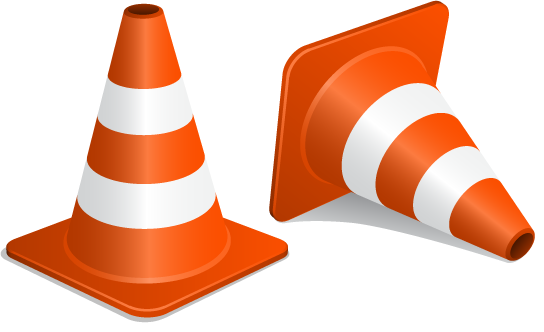
This image has format transparent PNG with resolution 544x332.
You can download this image in best resolution from this page and use it for design and web design.
Cones PNG with transparent background you can download for free, just click on download button.
Traffic cones, also called pylons, witches' hats, road cones, highway cones, safety cones, channelizing devices, construction cones, or just cones, are usually cone-shaped markers that are placed on roads or footpaths to temporarily redirect traffic in a safe manner. They are often used to create separation or merge lanes during road construction projects or automobile accidents, although heavier, more permanent markers or signs are used if the diversion is to stay in place for a long period of time.
Traffic cones were invented by Charles D. Scanlon, an American who, while working as a painter for the Street Painting Department of the City of Los Angeles, was unimpressed with the traditional wooden tripods and barriers used to mark roads which were damaged or undergoing repainting. Scanlon regarded these wooden structures as easily broken, hard to see, and a hazard to passing traffic.Scanlon's rubber cone was designed to return to an upright position when struck by a glancing blow. The patent for his invention was granted in 1943.
Traffic cones were first used in the United Kingdom in 1958, when the M6 motorway opened. These traffic cones were a substitute for red lantern paraffin burners being used during construction on the Preston Bypass. In 1961, David Morgan of Burford, Oxfordshire, UK believes that he constructed the first experimental plastic traffic cones, which replaced pyramid-shaped wooden ones previously used.
In the United States on May 1, 1959 the Pacific Gas and Electric Company in Oakland, California adopted the policy of placing the orange safety cones at the left front and left rear corners of their service trucks while parked on the street to increase visibility and safety for the workers. This policy was implemented as the result of a suggestion by their employee, Russell Storch, a cable splicer. He was awarded $45 for his suggestion. This policy is still in use today.
Although originally made of concrete, today's versions are more commonly brightly colored thermoplastic or rubber cones. Recycled PVCs from bottles can be used to create modern traffic cones. Not all traffic cones are conical. Pillar-shaped movable bollards fulfill a similar function.
In this clipart you can download free PNG images: Cones PNG images free download, orange cones PNG